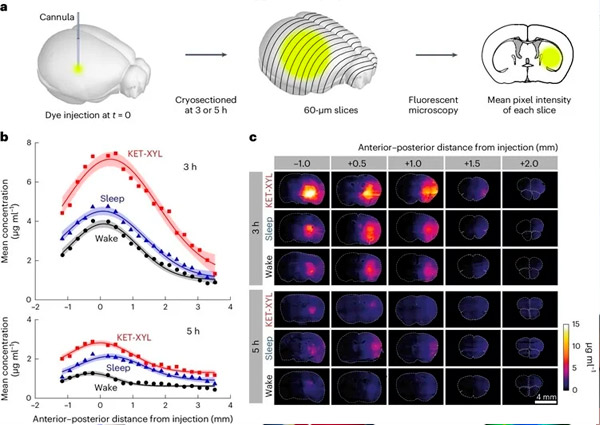Sleep cleanses the brain of toxins and metabolites
Sist anmeldt: 14.06.2024

Alt iLive-innhold blir gjennomgått med medisin eller faktisk kontrollert for å sikre så mye faktuell nøyaktighet som mulig.
Vi har strenge retningslinjer for innkjøp og kun kobling til anerkjente medieområder, akademiske forskningsinstitusjoner og, når det er mulig, medisinsk peer-evaluerte studier. Merk at tallene i parenteser ([1], [2], etc.) er klikkbare koblinger til disse studiene.
Hvis du føler at noe av innholdet vårt er unøyaktig, utdatert eller ellers tvilsomt, velg det og trykk Ctrl + Enter.

A recent study published in Nature Neuroscience found that brain clearance is reduced during anesthesia and sleep.
Sleep is a state of vulnerable inactivity. Given the risks of this vulnerability, it is suggested that sleep may provide some benefits. It has been hypothesized that sleep clears the brain of toxins and metabolites through the glymphatic system. This assumption has important implications; for example, reduced detoxification due to chronically poor sleep may worsen Alzheimer's.
The mechanisms and anatomical pathways through which toxins and metabolites are cleared from the brain remain unclear. According to the glymphatic hypothesis, the basal fluid flow, driven by hydrostatic pressure gradients from arterial pulsations, actively clears salts from the brain during slow-wave sleep. In addition, sedative doses of anesthetics enhance clearance. It remains unknown whether sleep increases clearance through increased basal flow.
In this study, scientists measured fluid movement and brain clearance in mice. First, the diffusion coefficient of fluorescein isothiocyanate (FITC)-dextran, a fluorescent dye, was determined. FITC-dextran was injected into the caudate nucleus, and fluorescence was measured in the frontal cortex.
The first experiments involved waiting for a steady state, bleaching the dye in a small volume of fabric, and determining the diffusion coefficient from the speed of movement of the unbleached dye into the bleached area. The technique was validated by measuring the diffusion of FITC-dextran in brain-mimicking agarose gels that were modified to approximate the optical absorption and light scattering of the brain.
The results showed that the diffusion coefficient of FITC-dextran did not differ between anesthesia and sleep states. The team then measured brain clearing in different states of wakefulness. They used a small volume of the fluorescent dye AF488 in mice that were injected with saline or an anesthetic. This dye moved freely in the parenchyma and could help accurately quantify brain clearance. Comparisons were also made between waking and sleeping states.
At peak concentrations, clearance was 70–80% in saline-treated mice, indicating that normal clearance mechanisms were not impaired. However, significant reductions in clearance were observed when anesthetic agents (pentobarbital, dexmedetomidine, and ketamine-xylazine) were used. Additionally, clearance was also reduced in sleeping mice compared to awake mice. However, the diffusion coefficient was not significantly different between anesthesia and sleep conditions.

A. 3 or 5 hours after injection of AF488 into CPu, brains were frozen and cryosectioned into 60-μm-thick sections. The average fluorescence intensity of each section was measured using fluorescence microscopy; then the mean intensity values of the groups of four slices were averaged.
B. Mean fluorescence intensity was converted to concentration using the calibration data presented in Supplementary Figure 1 and plotted against anteroposterior distance from the injection point for the awake (black), sleep (blue), and KET-XYL anesthesia (red) states. Above - data after 3 hours. Below - data after 5 hours. Lines represent Gaussian fits to the data and error envelopes indicate 95% confidence intervals. Both 3- and 5-hour concentrations during KET-XYL anesthesia (P
C. Representative images of brain sections at different distances (antero-posterior) from the AF488 injection site at 3 hours (top three rows) and 5 hours (bottom three rows). Each row represents data for three waking states (awake, sleep, and KET-XYL anesthesia).
The study found that brain clearance was reduced during anesthesia and sleep, contradicting previous reports. Clearance may vary among different anatomical sites, but the degree of variation may be small. However, the inhibition of clearance by ketamine-xylazine was significant and independent of site.
Nicholas P. Franks, one of the study's authors, said: "The research field has been so focused on the idea of purification as one of the key reasons why we sleep that we were very surprised by the opposite results."
It is especially important to note that the results concern a small volume of dye that moves freely in the extracellular space. Larger molecules may exhibit different behavior. In addition, the precise mechanisms by which sleep and anesthesia influence brain clearance remain unclear; however, these findings challenge the idea that sleep's primary function is to clear the brain of toxins.
